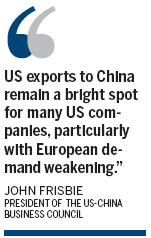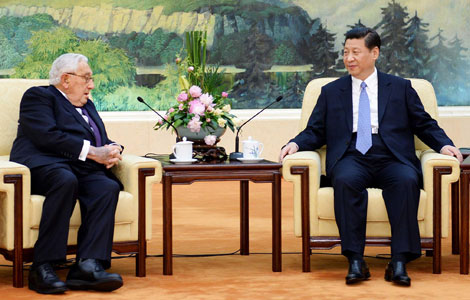Chinese consumers push US exports higher
Updated: 2013-04-25 11:01
By Zhang Yuwei in New York (China Daily)
|
||||||||

China remained the United States' third-biggest export destination, behind Canada and Mexico, in 2012, having purchased nearly $109 billion US goods, according to a report by the US-China Business Council.
Each of 30 US states exported more than $1 billion in goods to China while 10 others shipped more than $500 million. Leading industries were agriculture, transportation and electronics, the Washington-based organization said in an annual survey to be released on Thursday.
Although GDP growth in the world's No 2 economy slowed last year, China still saw the value of imports from the US increase by 6.5 percent, or $6.6 billion, the USCBC says.
That helped boost the US economy and contribute to job creation, said John Frisbie, president of the council, which represents more than 200 US companies that do business in China.
"US exports to China remain a bright spot for many US companies, particularly with European demand weakening," Frisbie said.
Timothy Speiss, an executive with New York consulting firm Eisner Amper LLP, said trade between the US and China is likely to increase this year.
"American companies looking for investors and American homeowners looking for buyers benefit from Chinese money coming to the US," he said.
China's first-quarter GDP growth rate of 7.7 percent was slightly above the government's 7.5 percent target but below the 8 percent prediction of several leading economists, including Justin Lin, a former World Bank chief economist.
But a rapidly expanding middle class has become a major driver of China's buying power. A recent report by the Paris-based Organization for Economic Cooperation and Development said that trend outpaced overall investment in China in 2011.
The Chinese middle class accounts for nearly a quarter - $6.2 trillion - of the $26 trillion in additional global consumption projected for the 15 years leading up to 2025, according to consulting firm McKinsey & Co.
"As its economy and middle class expand, China will continue to play a significant role as an export market for a wide selection of US goods," Frisbie said. "Some estimates forecast that China may have nearly 600 million middle-class consumers by the end of the decade."
Jeremy Haft, a professor in Georgetown University's Asia-studies program, said "powerful" market forces in China have enabled US exports to grow.
"As China continues to improve its agricultural capability and food safety, there will continue to be high demand for US agriculture/food exports," he said, referring to a major category in the countries' trade.
"China's dynamic, growing middle class will continue to purchase value-added US products and services," said Haft, author of All the Tea in China, a book that argues the US could leverage its competitive advantage over China to create jobs.
The USCBC report says US exports to China rose 294 percent, or nearly $81 billion, between 2003 and 2012. Forty-two states had export growth rates in the triple digits during that period, while four -Alabama, Nevada, South Carolina and Vermont - had increases of 1,000 percent or more.
Last year, US exports to China covered a range of sectors, including crop production, transportation equipment, electronics, chemicals and machinery.
But Haft said more categories should be added to sustain the growth pace.
"Even though exports to China are growing very fast and from nearly every congressional district in the country, export intensity remains low - there are many more products and services that America could be selling to China, thus creating and sustaining American jobs," he explained.
Although China continues to be the No 3 destination for US exports, the USCBC report notes that the US share of all imports China receives fell to 7 percent last year from 10 percent in 2000. The US in 2012 was the fourth-biggest source of Chinese imports, after the European Union, Japan and South Korea.
"To help strengthen America's competitiveness in China, policymakers should consider developing a new US trade objective: Reclaim a 10 percent share of China's imports by 2015," Frisbie said. "Regaining a 10 percent share of China's import market will help US companies provide innovative products and services to China, boosting overall US sales and global competitiveness."
yuweizhang@chinadailyusa.com
Most Viewed
Editor's Picks

|

|

|

|

|

|
Today's Top News
Sluggish growth takes its toll on foreign lenders
Investors find a home in overseas real estate
More Chinese travel overseas, study reveals
Xi meets former US heavyweights
Li in plea to quake rescuers
Canada to return illegal assets
Beijing vows to ease Korean tensions
Order restored after deadly terrorist ambush
US Weekly

|

|














